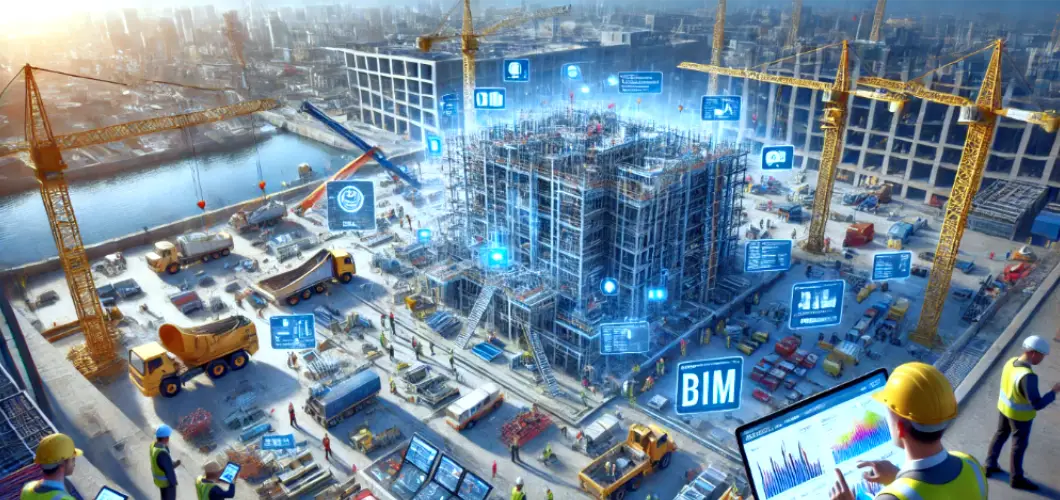
Understanding BIM Engineering: Revolutionizing Construction Projects
Thanks to Building Information Modelling (BIM), the architecture, engineering, and construction (AEC) industry has revolutionized. Project planning, designing, management, and construction have changed.
In this article, our experts will explore how BIM engineering has changed the AEC landscape and what the future holds for it. So, stay with us!
What is BIM Engineering?
Let’s break down the term BIM + engineering. So, we can define BIM engineering as applying BIM to engineering disciplines with construction projects. BIM empowers stakeholders with multidimensional modeling, unlike traditional 2D Computer-Aided Design (CAD) methods. It further helps improve project efficiency with data-driven processes. This approach encapsulates spatial relationships, quantities, geometric elements, and other properties of the building components. Combined, BIM engineering improves decision-making, communication, and collaboration among all stakeholders.
Components of BIM Engineering
The following are the components of BIM engineering:
3D Modelling & Visualization
Through BIM, you can create accurate 3D models that provide excellent visualization. Using these precise and accurate 3D models, you can visualize every aspect of a building or infrastructure project. Engineers use these models as digital prototypes to analyze spatial relationships and detect clashes. Similarly, engineers use these models to optimize the design process further before the construction begins. This proactive approach helps you avoid errors resulting in cost overruns and delays.
Data Integration and Management
We have said on a couple of occasions that BIM provides a central repository and becomes a single source of truth for all project teams, including architects, engineers, designers, and contractors. It integrates diverse data sources from architectural, structural, mechanical, and electrical systems. This data interoperability enhances coordination and reduces errors by ensuring that all project stakeholders work from a single source of truth. So, all teams have access to updated information in real time.
Collaborative Workflows
By becoming a single source of truth, BIM fosters collaboration among architects, engineers, contractors, and facility managers through cloud-based platforms and real-time project updates. This approach to project delivery that thrives in a collaborative environment promotes transparency, streamlines communication, and improves project outcomes.
Analysis & Simulation
Traditional BIM methods lack the luxury of simulation and analysis. However, BIM empowers engineers with advanced analysis and simulation. These include structural analysis, energy performance assessment, and construction sequencing. This feature is extremely helpful in optimizing every aspect of the construction project, such as making the design more efficient, mitigating risks, and improving overall efficiency. All of this translates into cost and time savings while adhering to strict deadlines.
Facility Management and Maintenance

The benefits of BIM engineering go way beyond construction and project delivery; it supports facility management. How? BIM provides detailed and accurate as-built data and maintenance schedules to facility managers. With access to this valuable information, you can manage building operations far more efficiently. This digitization-driven approach to facility management reduces lifecycle costs while improving occupant satisfaction at the same time.
Check: The importance of bim in facility management
Advantages of BIM Engineering
Now that we have a quick overview of BIM engineering’s components, it’s time to explore some of its biggest advantages.
Improved Project Visualization
In the aforementioned paragraphs, we said that you can create accurate 3D models through BIM. These realistic 3D models improve project visualization and enable stakeholders to visualize design in context and make informed decisions. Likewise, this feature is extremely handy when it comes to design approval. Similarly, improved visualization helps your client and investors better understand the project outcomes.
Improved Collaboration
As BIM facilitates interdisciplinary collaboration, coordination errors, and reworks are reduced. Similarly, when errors and reworks are reduced significantly, your project timelines not only adhere to them but are also accelerated. By improving collaboration, BIM engineering ensures that all parties involved in your project are aligned and working towards common project goals.
Related: How bim enhances collaboration in construction
Cost & Time Saving
When communication and collaboration are improved, workflows are optimized, project visualization is enhanced, errors and conflicts are timely resolved, and material waste witnesses significant reduction, you save big in terms of time and cost.
Sustainability
When it comes to sustainability in the construction industry, concerns remain to grow. World Business Council for Sustainable Development highlighted that the construction industry accounts for 38% of total global emission. However, BIM engineering makes your practice more sustainable by supporting sustainable design and construction practices. Likewise, as there are fewer reworks due to proactive clash detection, there will be fewer carbon emissions. This BIM-led focus on sustainability helps achieve green building certifications and reduce the overall carbon footprint of construction projects.
Risk Mitigation
Through BIM engineering, you can have a proactive approach to risk mitigation. You can identify and resolve conflicts as early as in the design phase to keep costly reworks and delays at bay. This approach benefits you in terms of time and cost, makes your practice more reliable, and improves client satisfaction. And there’s no need to explain that a happy client means more projects and more business.
BIM Engineering – The DDC Way
If you want to achieve all the aforementioned goals, specifically making your practice compliant, reducing costs, and increasing profits, look no further, as DDC Solutions has got your back. We provide tailored BIM solutions. Our approach to BIM management is not about ticking pre-set BIM boxes. Rather, we offer bespoke solutions by integrating ourselves within your team to put your people, projects, and businesses ahead of everything else.
We have a proven track record of success, and you can witness the same in our project section. We are also led by one of the BIM pioneers, Jimi Clarke. Our highly experienced team uses the latest tools and software to give unrivalled results in every aspect of BIM. Want to explore more or get a free quote? Book your free consultation today.

